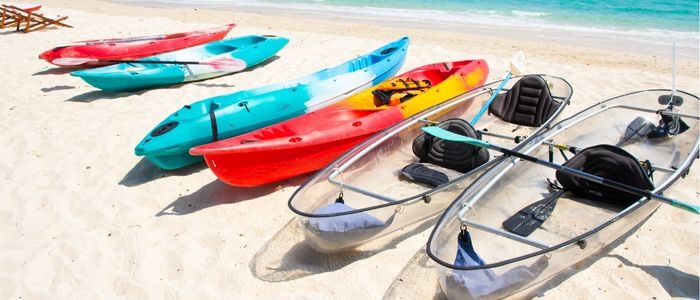
Knowing which kayak is most stable is crucial when choosing your first kayak. It’s a lot more challenging to paddle a kayak that is prone to tipping over. So, let’s get to know which kayaks are more stable.
Types of the kayak with a flat bottom and flat hull are considered more stable than any other type of kayak. The reason is flat bottom makes more contact with the water, making it difficult to go faster but also more stable and difficult to flip over.
There are many different types of kayaks available in the market, and they all are different in terms of stability and other features. So, let’s compare some of them and determine which is more stable.
Following are some common types of kayaks available in the market nowadays. Let’s get to know which one is better when it comes to stability.

When it comes to stability, fishing kayaks come at number 1. They are specially designed to be more stable because they have a wider hull and more weight in the rear.
The best fishing kayaks have a wide hull, making them more stable than other kayaks. This is why they tend to be heavier and bulkier than other types of boats.
The wider the kayak’s hull, the more stable it will be. This means that fishing kayaks are generally much sturdier than other kayaks and can hold up well even in rough waters.
They also have a lot more weight in the back, which gives them greater stability when compared with other boats.

Recreational Kayaks are also considered stable because they have a wide base and a low center of gravity. The wide base helps keep the kayak from tipping over, while the low center of gravity helps keep the keel straight in the water.
Recreational kayaks are designed for fun outdoor recreation rather than serious sports competitions or expeditions. They are usually made from plastic or fiberglass and can be used on lakes or rivers where speed is not a priority. That is why they are considered more stable than other types of kayaks but are less stable than fishing kayaks.
They also have a larger cockpit, making it easier to get in and out of the kayak. The weight of the kayak also affects its stability, but this is something that you can adjust by adding or removing weight from the back end of your kayak.
Touring kayaks are slightly stable but not more than recreational kayaks. They have a longer length and wider beam than other kayaks, making them stable and easy to handle. A touring kayak can be used for both fishing and recreational purposes.
The main difference between a recreational kayak and a touring kayak is that touring kayaks are longer and wider than recreational ones, allowing you to fit more gear into them. The extra width also makes them stable on the water, so you won’t need to worry about tipping over as much when you’re out on the water in your touring kayak.
Touring Kayaks are designed for long-distance paddling, which is why they can go fast. In fact, their speed is one of the main reasons that they are so popular. Besides that, they are stable enough but not more than fishing and recreational kayaks.
Tandem kayaks are also stable only when used on calm waters. In fact, they are one of the most stable boats for calm waters, which is why they are used for competitive racing.
Tandem kayaks are made up of two people sitting back-to-back, with the person in front and the person in back using their hands to paddle the boat forward. This makes it easy for both paddlers to keep their balance and control their movements.
The only issue that can arise from tandem kayaking is if one person falls out of sync with the other, which happens rarely, and usually only when one paddler gets tired or lose control. But when it does happen, it’s usually dangerous because it can flip over the boat. That is why tandem kayaks are not considered as stable as the ones mentioned above.
These kayaks are designed so that each person has an equal amount of weight bearing down on them at all times; that is why when one person falls out, it automatically unbalances the other person and the boat.
Modular kayaks are a type of boat that can be disassembled and re-assembled, making them more portable and easier to store. They are also great for people with limited space to store their kayak or who want to easily travel by boat.
Modular kayaks are more prone to tipping over than non-modular kayaks because they have fewer contact points with the water. That is why they are not considered stable as compared to other types of kayaks.
While modular kayaks are generally less stable than traditional kayaks, they can still be a great choice for intermediates, especially if you plan on using them exclusively on lakes and your local river, where there is no danger in case your kayak flips over, and you fall in the water.
But if you are a beginner, modular kayaks are not recommended because risking your life is not a good thing.
When it comes to stability, sit-on-top kayaks can be prone to tipping over if they are not properly balanced. Because they don’t have a cockpit that encloses the user’s feet, you have to be careful not to overload your boat with weight or cargo so that it doesn’t become too heavy for the hull design.
Sit-in kayaks are more stable than sit-on-top options because they have an enclosed cockpit that improves the center of gravity on the water and keeps your body safe from falling out of the boat. This means that you can safely store items inside your cockpit without fearing them falling out if you capsize during use.
They also have a lower center of gravity, making it easier to turn in shallow waters where there’s less drag from the bottom.
Many factors affect the stability of a kayak. So, you must understand those factors to choose a stable kayak according to your needs.
When it comes to stability, the size and dimension of your kayak are the most important factors. The bigger or wider your kayak is, the more stable it will be in the water. This is because a larger boat is likely to have more weight distributed across its surface area, making it less likely to tip over.
The length of your kayak also plays a role in its stability. Longer boats tend to be less stable than shorter ones because they have greater heft and are prone to flip over when the rider is unbalanced.
So, the larger the kayak volume is, the more stable it would be.
The hull design is another most important factor affecting a kayak’s stability. A kayak’s hull design will determine how easily it can turn, how fast it can move, and how well it handles rough waters.
It is the part of the kayak that makes it float in the water and has two main functions: to create a low center of gravity and cut through the water. The hull design also affects the kayak’s ability to keep your body balanced in the water.
The hull design has a huge impact on how stable your kayak is. If you have a boat with a low-sloping hull, it will be more stable than one with a high-sloping hull.
The design of the bottom of your kayak is incredibly important in terms of stability, as it affects how easily you can control your kayak. A flat bottom is generally considered more stable than a rounded or v-shaped bottom, but all three shapes have their advantages.
Rounded bottoms tend to be more efficient and faster, while flat bottoms are easier to maneuver at low speeds and turn sharply when paddling with one hand. V-shaped bottoms are known for being very stable but also tend to be harder to turn and slow down in moving water due to their length.
Another important factor affecting a kayak’s stability is its weight distribution. If your weight is not distributed equally, you will find it harder to control the kayak and keep it upright, making it not stable.
If you carry more weight on one side of the kayak, it will tip over more easily. So, the weight of your kayak should be distributed evenly throughout the boat. If the weight is not distributed evenly, you may tip over when you try to turn sharply, or the boat may be difficult to paddle.
The Center of gravity is another important factor affecting a kayak’s stability. The center of gravity is the point at which all the weight in a boat balances out. It is usually located near the middle of the boat but can be moved forward or back depending on how much weight you have in your kayak.
The more weight concentrated towards the front of your kayak, the less stable it will be. This means that if you have too much gear stored in your kayak’s front compartment, it might tip over easily when you lean back to paddle or if strong winds are pushing against it from behind.
So, kayaks with a lower center of gravity are more stable than others.
There are many different types of kayaks available in the market, but the most stable one is one with a flat bottom or wider hull. Flat bottom kayaks are more connected to the water, producing more fractions, making them less likely to flip over and more stable than any other kayak.
Similarly, if we talk about the most stable types of kayaks, then the fishing kayaks are considered a good fit because they come with a usually flat bottom and wider hull to hold more weight while being on the water.

Hey there kayak lovers! I’m Jay Schwartz, the author here at Kayak Guidance! You know water sports – you know me! My life is all about it. Kayaking, Paddleboarding, Fishing, Snorkeling and so much more. I love to share my passion and knowledge with all of you.

Hey there kayak lovers! I’m Jay Schwartz, the author here at Kayak Guidance! You know water sports – you know me! My life is all about it. Kayaking, Paddleboarding, Fishing, Snorkeling and so much more. I love to share my passion and knowledge with all of you.

Welcome to KayakGuidance.com! If you’re looking to have some fun outdoor water adventures, then you have come to the right place. We help our readers find the best kayaks and water related equipment to help you have the best time of your life whenever you are engaging in water activities.
This site is a participant in the Amazon services LLC associates program, an affiliate advertising program designed to provide a means for sites to earn advertising fees by advertising and linking to Amazon.com.